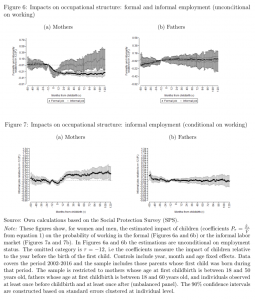With 2 billion people working informally, 93 percent in low- and middle-income countries, informality has consistently been associated with low productivity and poverty. The informal sector refers to activities that occur outside of regulated markets and is characterized by workers who often do not pay taxes and have weak social protection. As in most other markets, gender disparities are persistent. Globally, women have an employment rate of 58.1 percent with overrepresentation in sub-Saharan Africa, Latin America and the Caribbean, and Asia and the Pacific. These circumstances present unique challenges and opportunities in decisions about motherhood.
The International Labour Office identifies inadequate maternity protection, high vulnerability to loss of income and maternity-related costs, exclusion from legal protection and conventional social security schemes, exposure to work-related hazards, and insufficient access to health care provision as the key challenges to motherhood under informal employment. Yet, even among these undesirable conditions, an incentive for women to work informally after having their first child might still exist. A recent paper from the Universidad Nacional de La Plata takes an event-study approach and examines the role of informal sector job opportunities on mothers’ labor market decisions in Chile, an OECD country with relatively large informality.
At the onset of motherhood in Chile, there is a sharp decline in women’s labor supply: labor force participation (LFP) falls by 17 percent (extensive margin) and 20 percent (intensive margin); hours worked falls by 4 to 5 percent; part-time employment rises by 40 percent; hourly earnings fall by 10 to 15 percent. For the ten years following the birth of their first child, these changes remain relatively constant. However, with the opportunity to pursue a job in the informal sector with flexible working hours, the decline in formal employment agrees with an increase in informal employment.
The paper’s counterfactual experiment, which eliminates the channel of informality, shows that Chile’s informal sector helps lessen the decline in LFP among new mothers by about 35 percent. With a few part-time jobs available and a weak interest in public sector jobs, informality becomes a family-friendly option. At the birth of their first child, women’s informal employment rate increases by about 26 percent and does not significantly change for fathers.

When controlling for the mothers’ educational attainment, some college education versus no college education, less educated women have a sharper decline in employment and hours worked per week and are more likely to work part-time. Conditional on working, this group is also more likely to be employed informally after their first child is born. A negative motherhood effect on the labor outcomes of less educated women restricts their opportunity to gain valuable formal market skills in the long run.
Beyond the absence of social protection that mothers often encounter in informal economies, considering the role that informality has in women’s labor decisions is necessary for effective policymaking, particularly in developing countries. The integration and productive participation of mothers in low- and middle-income economies will not occur unless their choices can be understood in their respective contexts.

I completely agree with you that the integration and productive participation of mothers in low- and middle-income economies will not occur unless their choices can be understood in their respective contexts.